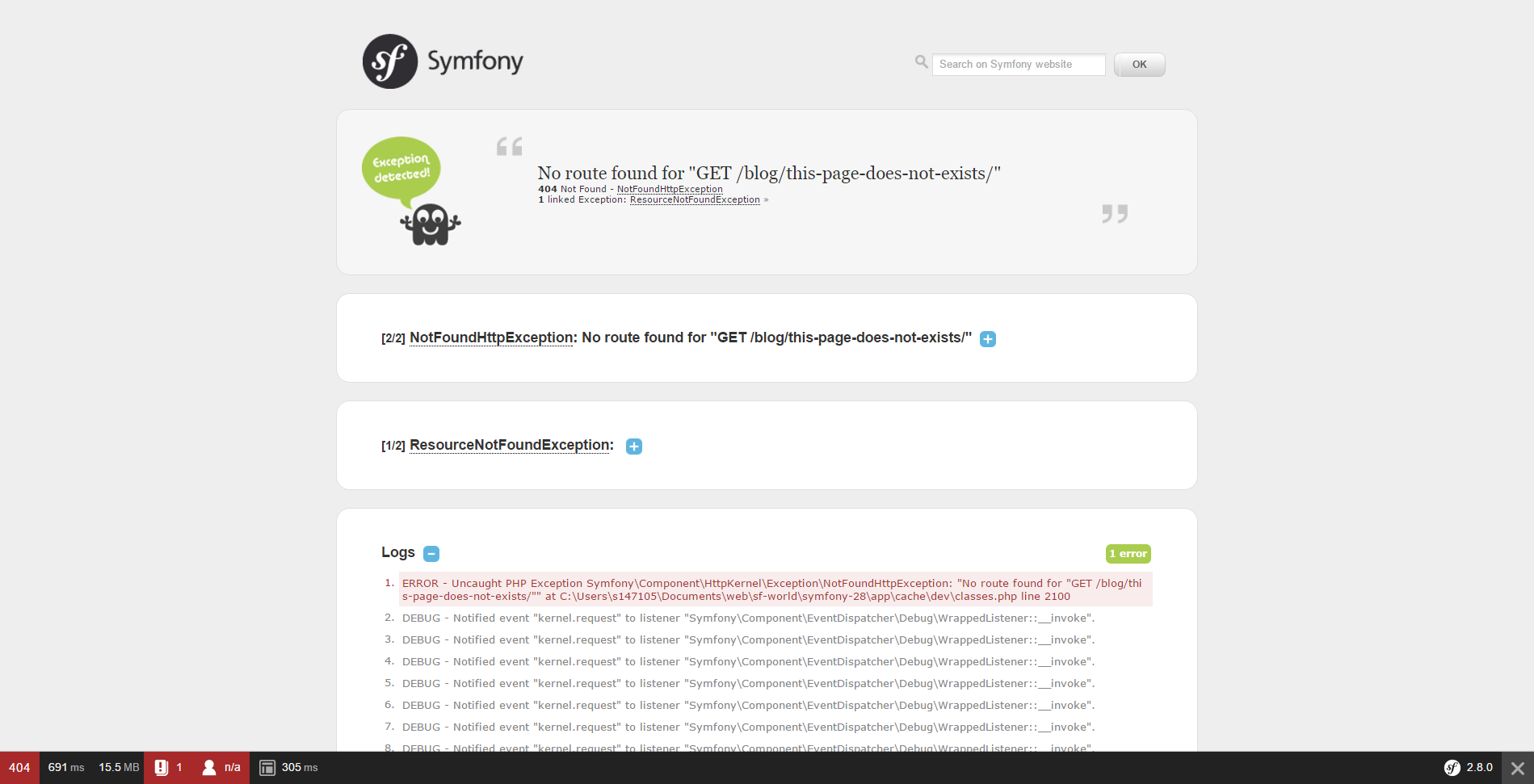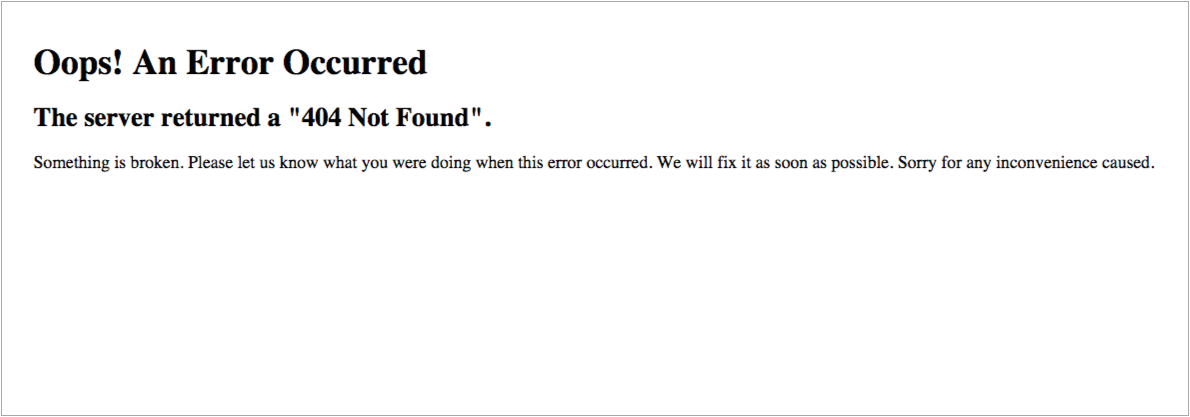How to Customize Error Pages
Warning: You are browsing the documentation for Symfony 2.x, which is no longer maintained.
Read the updated version of this page for Symfony 7.2 (the current stable version).
In Symfony applications, all errors are treated as exceptions, no matter if they are just a 404 Not Found error or a fatal error triggered by throwing some exception in your code.
In the development environment, Symfony catches all the exceptions and displays a special exception page with lots of debug information to help you quickly discover the root problem:

Since these pages contain a lot of sensitive internal information, Symfony won't display them in the production environment. Instead, it'll show a simple and generic error page:

Error pages for the production environment can be customized in different ways depending on your needs:
- If you just want to change the contents and styles of the error pages to match the rest of your application, override the default error templates;
- If you also want to tweak the logic used by Symfony to generate error pages, override the default exception controller;
- If you need total control of exception handling to execute your own logic use the kernel.exception event.
Overriding the Default Error Templates
When the error page loads, an internal ExceptionController is used to render a Twig template to show the user.
This controller uses the HTTP status code, the request format and the following logic to determine the template filename:
- Look for a template for the given format and status code (like
error404.json.twigorerror500.html.twig); - If the previous template doesn't exist, discard the status code and look for
a generic template for the given format (like
error.json.twigorerror.xml.twig); - If none of the previous template exist, fall back to the generic HTML template
(
error.html.twig).
To override these templates, simply rely on the standard Symfony method for
overriding templates that live inside a bundle:
put them in the app/Resources/TwigBundle/views/Exception/ directory.
A typical project that returns HTML and JSON pages, might look like this:
1 2 3 4 5 6 7 8 9 10 11
app/
└─ Resources/
└─ TwigBundle/
└─ views/
└─ Exception/
├─ error404.html.twig
├─ error403.html.twig
├─ error.html.twig # All other HTML errors (including 500)
├─ error404.json.twig
├─ error403.json.twig
└─ error.json.twig # All other JSON errors (including 500)Example 404 Error Template
To override the 404 error template for HTML pages, create a new
error404.html.twig template located at app/Resources/TwigBundle/views/Exception/:
1 2 3 4 5 6 7 8 9 10 11
{# app/Resources/TwigBundle/views/Exception/error404.html.twig #}
{% extends 'base.html.twig' %}
{% block body %}
<h1>Page not found</h1>
<p>
The requested page couldn't be located. Checkout for any URL
misspelling or <a href="{{ path('homepage') }}">return to the homepage</a>.
</p>
{% endblock %}In case you need them, the ExceptionController passes some information to
the error template via the status_code and status_text variables that
store the HTTP status code and message respectively.
Tip
You can customize the status code by implementing
HttpExceptionInterface
and its required getStatusCode() method. Otherwise, the status_code
will default to 500.
Note
The exception pages shown in the development environment can be customized
in the same way as error pages. Create a new exception.html.twig template
for the standard HTML exception page or exception.json.twig for the JSON
exception page.
Testing Error Pages during Development
While you're in the development environment, Symfony shows the big exception page instead of your shiny new customized error page. So, how can you see what it looks like and debug it?
Fortunately, the default ExceptionController allows you to preview your
error pages during development.
To use this feature, you need to have a definition in your
routing_dev.yml file like so:
1 2 3 4
# app/config/routing_dev.yml
_errors:
resource: "@TwigBundle/Resources/config/routing/errors.xml"
prefix: /_errorIf you're coming from an older version of Symfony, you might need to
add this to your routing_dev.yml file. If you're starting from
scratch, the Symfony Standard Edition already contains it for you.
With this route added, you can use URLs like
1 2
http://localhost/app_dev.php/_error/{statusCode}
http://localhost/app_dev.php/_error/{statusCode}.{format}to preview the error page for a given status code as HTML or for a given status code and format.
Overriding the Default ExceptionController
If you need a little more flexibility beyond just overriding the template, then you can change the controller that renders the error page. For example, you might need to pass some additional variables into your template.
To do this, simply create a new controller anywhere in your application and set the twig.exception_controller configuration option to point to it:
1 2 3
# app/config/config.yml
twig:
exception_controller: AppBundle:Exception:showExceptionThe ExceptionListener
class used by the TwigBundle as a listener of the kernel.exception event creates
the request that will be dispatched to your controller. In addition, your controller
will be passed two parameters:
exception- A FlattenException instance created from the exception being handled.
logger-
A DebugLoggerInterface
instance which may be
nullin some circumstances.
Instead of creating a new exception controller from scratch you can, of course,
also extend the default ExceptionController.
In that case, you might want to override one or both of the showAction() and
findTemplate() methods. The latter one locates the template to be used.
Note
In case of extending the
ExceptionController you
may configure a service to pass the Twig environment and the debug flag
to the constructor.
1 2 3 4 5
# app/config/services.yml
services:
app.exception_controller:
class: AppBundle\Controller\CustomExceptionController
arguments: ['@twig', '%kernel.debug%']And then configure twig.exception_controller using the controller as
services syntax (e.g. app.exception_controller:showAction).
Tip
The error page preview also works for your own controllers set up this way.
Working with the kernel.exception Event
When an exception is thrown, the HttpKernel
class catches it and dispatches a kernel.exception event. This gives you the
power to convert the exception into a Response in a few different ways.
Working with this event is actually much more powerful than what has been explained before, but also requires a thorough understanding of Symfony internals. Suppose that your code throws specialized exceptions with a particular meaning to your application domain.
Writing your own event listener
for the kernel.exception event allows you to have a closer look at the exception
and take different actions depending on it. Those actions might include logging
the exception, redirecting the user to another page or rendering specialized
error pages.
Note
If your listener calls setResponse() on the
GetResponseForExceptionEvent,
event, propagation will be stopped and the response will be sent to
the client.
This approach allows you to create centralized and layered error handling: instead of catching (and handling) the same exceptions in various controllers time and again, you can have just one (or several) listeners deal with them.
Tip
See ExceptionListener class code for a real example of an advanced listener of this type. This listener handles various security-related exceptions that are thrown in your application (like AccessDeniedException) and takes measures like redirecting the user to the login page, logging them out and other things.